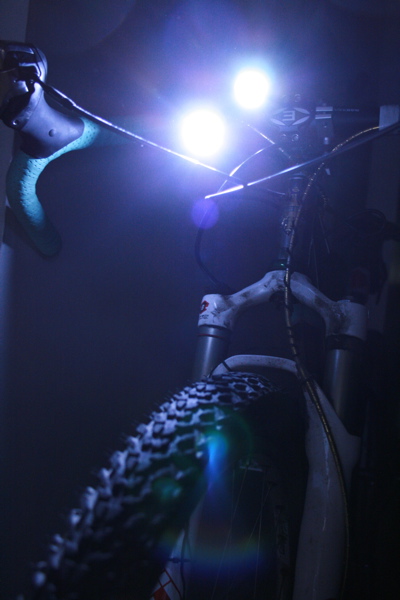Light and Motion Stella 300 Dual

The high summer seems like an odd time to test headlights, but that’s what I’ve been doing for the past month with . Meant for commuting as well as trail riding, the Stella 300 was as much light as I’ve ever wanted, and I could almost ignore the 300gr weight penalty. And just to keep with the 300 theme, that’s how much it costs, as in $US.
Developed from the Stella single lamp series, the 300 Dual shares the same aluminium head with CNC-machined cooling fins. The bulbs are 150 lumen LEDs, one spot and one flood. The flood has a diffuser on the lens, but my curiosity stopped short of breaking open the head to see if the flood’s reflector differed from the spot. The two heads mount independently of each other, though they are tethered to the same Y-cable. This allows you to independently target the flood and spot, and I generally pointed the flood somewhat below the spot, especially offroad.
The mounts consist of rubber straps that snug down the handlebar, requiring relatively little real estate near the stem. The mounts’ simplicity lends ease of installation and light weight, but the heads are far from locked into position. If the heads were heavier, this might lead to them being jarred askew on hard bumpy terrain, but the heads’ low mass was well checked by the strap. However, since the control button, mounted on the spot’s head, requires a deliberate press, toggling through settings during intense riding is both awkward and likely to redirect the spot.
The strobe setting uses both heads and does grab drivers’ attention. I live on Capitol Hill, and between there and my girlfriend’s apartment is a couple of long downhills with few lights but lots of side streets. It doesn’t take much effort to break 30-35mph even on knobby tires, but cars pulling out are a constant threat. Even worse would be the dreaded oncoming left turn. Honestly, I kinda hate strobe lights outside of a rave club, but I love to kick it on for that downhill run.
Riding offroad at night is not my particular forte, but the Stella 300 Dual makes the adventure practical. Not so much that I want to go exploring new trails at night, but enough so that I’ll try old haunts when the stars are out. On road, the system offers as much performance as I think anyone could need, though there is always some rider who would feel safer with a air raid searchlight mounted to front of their bike.
About the size of a fist, the lithium-ion battery mounts to the top tube with a velcro strap. The stout connector should seal out water, but I’ll just have to assume that since rain is scarce in Seattle’s summer. That will change in the fall, of course. I plan on using the Stella 300 Dual to expand my riding when the weather is soggy and the days are short. Hopefully I’ll able to give a long term evaluation on the light’s durability and battery performance after many more hours and charging cycles.